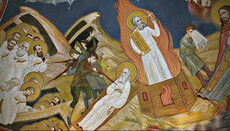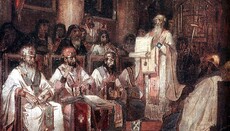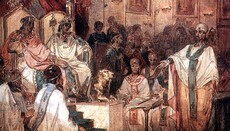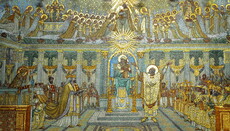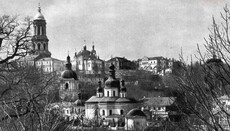Expulsion of the Church from the Lavra: Striking Parallels with XX Century
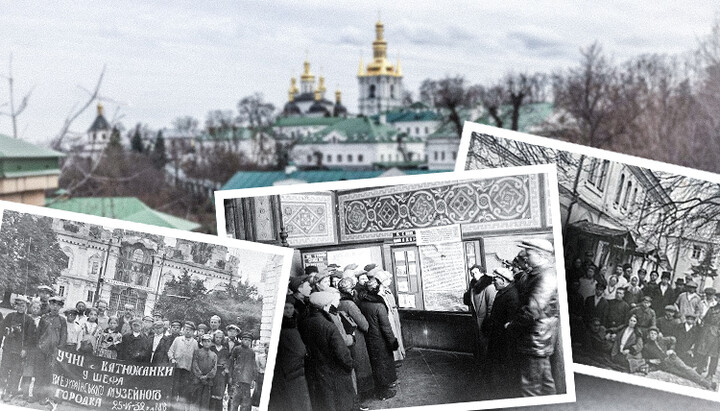
There was once a military rehabilitation center in the Lavra. The persecution of the Lavra in XXI century mirrors the tragic history of the beginning of XX century.
The events that are now unfolding around the Kyiv-Pechersk Lavra and the UOC mirror the tragic pages of the "Red Terror" against the Church a hundred years ago. The Trotskys and Kaganoviches of the 21st century cynically continue the work of their predecessors, who smashed the Orthodox faith in our land at the beginning of the 20th century.
The little-known testimonies of the historian and archaeologist Nadezhda Linka, a contemporary of those events, documented that the deeds of the former and current persecutors, expropriators of church property, are identical.
Nadezhda Linka was a participant in the creation of the All-Ukrainian Museum Town on the territory of the Kyiv-Pechersk Lavra, and later – a senior researcher at the Institute of History. Her memoirs show that the repetition of today's persecution against the Lavra and the Church as a whole is of a programmatic nature and coincides in detail with the scenario of the destruction of the faith by the Chekists of the GPU / Cheka. The headlines in the odious Bezbozhnik magazine do not differ much from the slogans of today's activists: "The monks' den must be destroyed", "The monks' shelter in the state museum". At the entrance to the Lavra, above the Holy Doors, hung a huge red slogan: “Monks are the bloody enemies of the working people.”
The recent proposal of the Minister of Culture Tkachenko to create “structures for the rehabilitation of the military” on the territory of the Lavra seems to have been cloned from the Bolshevik circulars.
According to them, exactly one hundred years ago, in 1923, “comrades Mausers” from the social security services established a town on the territory of the monastery for the disabled of the revolution and those who suffered on the fronts of the war.
Disabled by the revolution in Lavra
The legal adviser of the Lavra, Professor Ivan Nikodimov, wrote that the residents of the town for the Disabled behaved in a peculiar way: “Already at the entrance to the Lavra, the pilgrims were encountered with screams, drunken songs, music, swearing, and noise.”
In “Essays on the History of the Kiev-Pechersk Lavra and the Reserve” (Kiev, 1992) we read: “Despite the fact that the Museum of Cults and Life, as well as a number of other scientific, cultural and educational institutions, functioned on the territory of the Lavra, in 1923-1926, the town for the Disabled was the actual owner here (there was also a Prosthetic Factory, a production artel and Polytechnic Courses for the Disabled).
These very peculiar residents, as well as their frequent guests – "parishioners" of the town on the territory of the holy place, having drunk denatured alcohol or some kind of fusel alcohol, defecated at the altar walls of churches, defiled the Christmas necropolis near the Far Caves, where, along the way, spitting on the graves, they crushed the tombstones of their prominent compatriots, staged drunken orgies, scenes of outright debauchery, sang blatant songs with obscenities.
The police did not intervene very much unless it came to stabbing or some other violence ... To evict "comrades who received disabilities on the fronts of the revolution" was almost a hopeless case.
Archival documents testify that disabled people "wounded on the Kolchak fronts" plundered and destroyed church property, burned antique furniture in furnaces, beat two-hundred-year-old porcelain dishes, seeing on them, for example, a portrait of a tsar or a coat of arms with a double-headed eagle. The administration of the town illegally sold church valuables. The director of the museum, Kurinny, informed the state security authorities that the disabled were attempting to seize the museum premises. For example, shortly before the Lavra was reorganized into a Historical Reserve, disabled people tried to occupy the Economic Building and the Church of All Saints.”
"Stocktaking" of relics
Historian Nadezhda Linka described in detail the closing of the churches of the Lavra and the "inventory of exhibits" – the relics of revered Orthodox saints, the Reverend Fathers of the Kiev Caves. According to her, in 1922, all the relics in the Near and Far Caves were unearthed and called “more or less mummified corpses and human bones” in the inventory of the commission. Subsequently, blasphemy was committed more than once in the "laboratory of relics": a microbiological analysis of "mummified corpses" was carried out.
“Since 1926, museums were set up in the museum town, developing their activities in an extremely complex and specific environment on the territory of the famous ancient monastery... Here, under the shadow of the centuries-old glory of the Lavra, there was a whole army of idlers, simulators and hangers-on who sat down next to the monastery table by the 20th century.. Until 1926, the monastic buildings were at the disposal of the district housing department, which placed their residents there.
In the Far Caves, several houses were provided to the invalids of the First World War, who completely lost their sight from the action of poisonous gases. These unfortunate blind men often consoled themselves by drinking in rather violent and obscene company. The monastery hotel with many separate rooms and apartments was densely populated by the families of workers and employees of neighboring factories and institutions. There were also monastery cellars, which were now leased to Vintrest (a wine company – Trans.), who kept large stocks of wine in them. Employees of this institution often took samples from their goods, willingly treated their neighbors and sold alcoholic beverages.
Many higher institutions believed that museums were a kind of almshouse, where one could accommodate any person who is no longer able to perform his main functions, but still requires some attention and assistance. These people, mostly party members, sick, disabled, and often alcoholics, occupied the vacated apartments. Some of them were enrolled into the staff of museums, although they had nothing to do with museum work and often behaved obscenely. All this very motley heterogeneous population of the museum town was in a state of constant hostility, disputes and strife over every inch of living space.
How the Ministry of Culture Bolsheviks took away property from the Church
The Bolsheviks began to capitalize all the property of the Lavra. Here is how N. Linka describes it:
“A government commission was appointed to inventory and transfer all property, there were representatives from the city committee and the district executive committee. Again, all museum ‘whales’ refused to participate in this unpleasant but completely unique, extraordinary procedure. And again, I was included in this commission from the museum as a ‘caveperson’ who had become accustomed to monastic customs. Their stocktaking began from the main Assumption Cathedral in the Upper Lavra and, above all, from the central altar. On the throne was a huge silver tabernacle (424 kg) in the form of a church, a product of the twentieth century, a gift from the manufacturer Kuzmichev. Gorgeous were the Gospels in silver frames, decorated with enamel, crosses, bowls, diskos – all the precious utensils given to the Lavra by many generations of believers.
But it was terrible and disgusting to see near this sacred luxury the filth and blasphemous mockery of the shrine, which was so highly exalted in the eyes of believers.
More than a meter thick zinc boxes were installed in some places in the walls of the altar to collect water flowing along the cold walls from the breath of people, from the flame of candles, lamps, censers. These water-collecting boxes were filled with stinking urine. Dirty rags, scraps of brocade, women's stockings were lying on the High Place.
The members of the commission and I were dumbfounded and felt uncomfortable. Only priest Mikhail (Chaly, renovationist), the last abbot of the monastery, a representative of the community, was not at all embarrassed and, in response to the exclamations of the commission, shrugged his shoulders and repeated, ‘We are all people, all people.’ He understood, of course, that his career was over, that nothing good was in store for him, and he did not hide his cynicism. Perhaps he hoped to gain favor of the members of the commission with such ‘anti-religious’ behavior.
A few days later, having finished the stocktaking in the Cathedral, the commission went to the Near Caves. We started with the Church of the Exaltation, built at the beginning of the 18th century over the entrance to the underground cemetery. In the altar of this church, there were few silver utensils, but there was even more dirt, disorder and obscenities than in the Cathedral. I moved away to describe the icons and gave the men a field of activity. They were laughing out loudly, while Fr. Mikhail got excited and shone with eloquence. One could certainly guess the topic of such a lively conversation. The next day we went to the Near Caves, where Fr. Mikhail completely loosened his belt and spat loudly at his seal before pressing it against the sealing wax. The lively male conversation resumed and was interrupted more than once by laughter. So the last hours of the once great, ancient monastery turned into a farce ...
The progress was slow with the tour guides. Some suspicious priest proposed his candidacy, having retired from his rank and trying to make a career in anti-religious work, then an old man came, assuring that he had graduated from the Faculty of History and Physiology, followed by an illiterate but brave guy from the "Union of Atheists" and the rest of that ilk. Checking the work of some of these guides was simply scandalous. The brave atheist was particularly outstanding: in the Assumption Cathedral, pointing to the steam heating grate, he prophesied that there "the unfortunate victims of the monastery executioners languished in the gloomy dungeons." Furthermore, in the church above the Near Caves, he orated: “Here, in the middle of the temple, a fountain of cologne ‘spurred’, naked women walked around, and the monks took them to secluded caves.’”
The terrible fate of blasphemers
The fate of a number of figures of the museum of cults and life, arranged on the site of the lot of the Blessed Virgin Mary, turned out to be terrible. N. Linka reports that one of the pioneers of this case, D. Shcherbakovsky, committed suicide by drowning himself in the Dnieper. People's Commissar for "cultural construction" in Ukraine, Skrypnyk, one of those who determined the party's policy towards the Church, shot himself in 1933. The compiler of the inventory of the icons of the Lavra during their removal, Chernogubov, whose actions matched his last name (it means dark-mouth – Trans. Note), “was a complete cynic to the marrow of his bones, his judgments could have defeated Mephistopheles”. He was shot at the end of 1941 by the German guards of the reserve. Others were incited and provoked to “whistle blow” and slander their colleagues only to be tried and repressed by their colleagues in return.
Deputy Director for Science Lobkov doomed himself to a shameful death. “An illiterate and impudent man, an ex-foreman, an alcoholic with a pockmarked face and small suspicious eyes, whose leadership boiled down to the fact that he called one of the heads of departments and growled: “You, make sure (an obscene expression) that you keep everything in order, there should be no counter-revolution!" He often struck visitors with strong expressions and a sharp aroma, because during periods of especially abundant use of strong drinks, he did not have time to dispatch his natural needs in a timely manner. At the end of the 30s, he was returning home at night after a night of drinking, being wasted, and lay down to rest in the locker of the Jewish Bazaar (now Victory Square), the frost was severe, and in the morning he was found frozen to death.
The struggle of a person or community with God and with His Church eventually leads to a struggle with Life. Because the one whose ally a person becomes in this struggle, even out of ignorance, embodies darkness, lies and death. And no matter how outwardly patriotic his words are, there is only death behind them. This is also confirmed by the "red terror" deployed against the Church of Christ today.
During the seizure of a temple in the Kyiv region, a man who pulled out a cross with a Crucifixion from the priest and threw it to the ground instantly died in convulsions in front of everyone. The Lord let millions see the video recording of this terrible death to admonish those who, succumbing to the frantic propaganda of false verbalists, were tempted and joined the theomachists of the 21st century.

